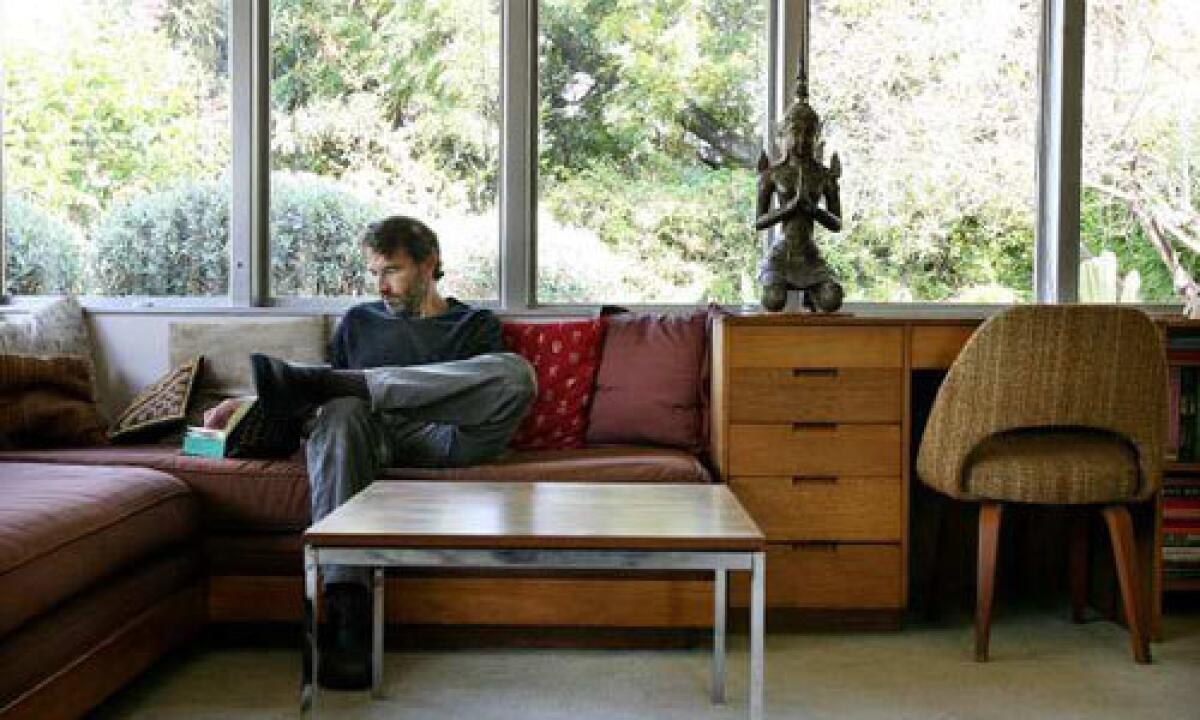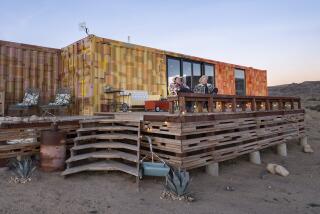Bit of genius

Architects in Southern California often look to the indoor-outdoor designs of the late trailblazing modernist Richard Neutra for inspiration. John Bertram need not look far. The 43-year-old principal of Bertram Architects lives in a Neutra: the 1939 McIntosh house.
Waking up every morning in a house designed by the architect who has most influenced him has been a boon for Bertram, whose portfolio includes million-dollar restorations and renovations of four historic Neutra homes, including the Brown house in Bel-Air owned by former Gucci designer Tom Ford. Bertram’s clients often have the financial means not only to afford these pedigreed properties but also to transform them into dream homes with cutting-edge technology and luxury materials. Bertram, however, comes home every day to something more modest and arguably more authentic: 900 square feet of architectural beauty and restraint, with just two bedrooms, one tiny bathroom and a kitchen that’s not much more than a hallway.
“I used to come home thinking I wanted to do the same here,” Bertram says of his glamorous Neutra makeovers. “Having lived in it, I don’t see that as a necessity.”
Neutra scholar Barbara Lamprecht deftly describes Bertram’s home in her definitive book, “Neutra, Complete Works”:
“This spare, lean house steps back from its quiet Silver Lake street in a series of low, compact volumes wrapped in horizontal redwood siding. The disparity between private and public agendas is extreme: The house is irrevocably closed to the public and exuberantly open on the view side.”
The clean lines, smooth surfaces, outside living spaces and open interiors filled with natural light were hallmarks of Neutra (1892-1970) and “a great celebration of the California climate [that] made him one of the leading architects of the modern era,” says Linda Dishman, executive director of the Los Angeles Conservancy, an organization devoted to preserving the city’s historic structures. “Neutra was very much an influence on the next generations of architects up to the present day.”
Bertram agrees, yet living in a Neutra has made him view the architect’s work more realistically.
“If you are too enchanted by the architecture, the tendency is to view a house uncritically and judge it largely on aesthetics and much less about how well it functions,” he says.
At 70 years old, the house Bertram shares with his wife, actress-writer Ann Magnuson, is not a “precious showplace,” he says. The late 1930s construction methods and old-growth redwood require relatively little maintenance.
“We appreciate the parts that are really great and accept the things that aren’t,” he says.
One of those things is its size, including a master bedroom that is a mere 11 feet square and a galley that is even smaller.
“I don’t know how much Neutra cared about kitchens,” Bertram says.
By contrast, the living and dining room are combined into an airy space that floats above the landscape. It is defined by a continuous band of view windows and doors that lead to the outdoors.
Looking at it from the bottom of the sloped garden, the modest house seems monumental, Bertram says. “Neutra was a complete master at finding the right site for building on a lot.”
The architect, noted for his thoughtful, modern, space-saving appointments, equipped the living room with a built-in mahogany writing desk, bookcase and L-shaped seating banquette. Even the dining table, whose pedestal doubles as a bookcase, was designed to be installed in its current position.
“Because of the open layout and the built-ins, you really don’t need a lot of furniture,” Bertram says.
Magnuson purchased the house shortly after the 1992 riots.
“The area was still dicey, but the price was right,” she says.
The couple met at a party at her home. Bertram says he went principally because it was a Neutra house. “The next morning my friend and I came back to help clean up, and Ann mentioned she wanted to get new cushions for the built-in sofa,” he says, adding that after this visit, “I was definitely more interested in her than reupholstering.”
The couple wed in 2002, and Magnuson says they have overcome one of the drawbacks of having an architecturally significant house.
“There is an expectation that you have the ‘right’ furniture, carpet, lamps, even landscaping,” she says. “While John was well-versed in the do’s and don’ts of midcentury modern restoration, he was refreshingly laid-back about it.”
He also had the benefit of his experience. Lamprecht credits Bertram for discovering that Neutra’s Wilkins residence in South Pasadena was a near-duplication of his Case Study No. 13 design, which was never built. Among Neutra owners and fans, Bertram is known as a scholar and thoughtful interpreter -- one who says the act of taking apart and rebuilding the master’s houses helps him to understand why and how they were designed and built.
“I could really get into the mind of Neutra and didn’t feel like I was doing something inappropriate or disrespectful, which gave me confidence in my own vision,” he says.
Developing his own architectural style that is informed but not dominated by Neutra has paid off handsomely in the Lookout residence, Bertram Architects’ most significant commission to date, which Bertram and associate Eliot Mitchell recently completed in Beverly Hills. It is fortress-like at the front. The back of the house, however, connects to the landscape with even more vigor and imagination than in Bertram’s own backyard.
Built on a flat lot, the Lookout house is a modified pinwheel design, one that Neutra used in the legendary Kaufmann house in Palm Springs to create multiple wings with dedicated outdoor spaces. On the exterior, the Lookout house achieves its sense of dynamic animation with stacked roof lines that have deep eaves and steel fascia trimming, dramatic structural walls that jut out into the landscape and multiple bands of cornered windows -- all parts of Neutra’s vocabulary that continue to resonate with Bertram.
“One thing that I love about Neutra’s buildings is that they are made of interlocking planes, almost like a house of cards,” Bertram says. Even though he calls it a relatively simple two-story structure, the Lookout residence “has the feeling of a cube-shaped house that is flying out of control and unraveling into space.”
Part of the beauty of Neutra’s compositions is a subtle asymmetry that is nonetheless balanced, Lamprecht says. “This house is absolutely and carefully calibrated with very specific views and openings to the outside that is obviously an hommage to Neutra,” she says.
Using a palette of smooth coat stucco, steel, limestone, walnut, terrazzo, glass and cork, Bertram amplified many of Neutra’s concepts. The result: rooms with visually seamless architectural elements that offer an array of quietly surprising details.
Among them: walls paneled floor to ceiling in walnut, pocket doors and wide-view windows with concealed frames. A floating wall made of split-face limestone has an inset display niche on one side and a hearth on the other. The sculptural staircase’s floating terrazzo treads are complemented by a glass railing. (Staircase cost: around $50,000.)
A far cry from the house Bertram lives in, the multimillion-dollar project took two years of construction to achieve its minimalist elegance. Though it exudes a debt to Neutra, the house is also very much the work of a contemporary architect adapting the tenets of classic Southern California modernism -- open-plan homes built for indoor-outdoor living -- for 21st century tastes. With a philosophical and practical knowledge of Neutra, Bertram isn’t insulted to be compared to his most obvious influence.
“For me, modernism was a high-water mark of architecture,” he says. “And Neutra established a rigorous set of rules for designing houses that are clear, precise, linear and dynamic.”
--






